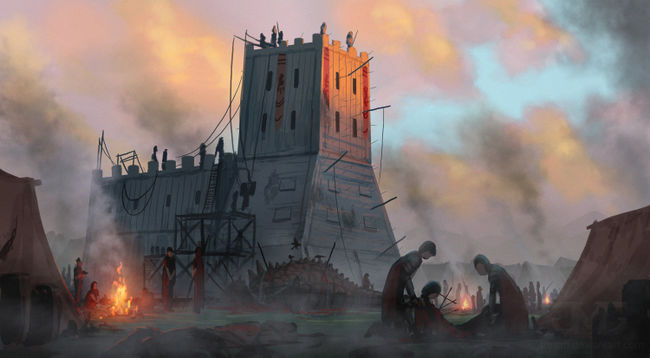Trains: Difference between revisions
No edit summary |
No edit summary |
||
| Line 1: | Line 1: | ||
[[File:train.jpg|650px|thumb|A small trade train.]] | [[File:train.jpg|650px|thumb|A small trade train.]] | ||
[[File:gigantys.jpg|650px|thumb|The Gigantys, a war train.]] | [[File:gigantys.jpg|650px|thumb|The Gigantys, a war train.]] | ||
=Trains= | =Trains= | ||
Revision as of 09:31, 21 January 2021


Trains
Trains are a rare and expensive form of transport, common in north Baracsa -- Benevis and northern Seleru due to the broad, high-quality roads mostly dating back to the Xilou Hoqomer. Overall, trains are massive wooden carriages, the smallest of which can be the size of a multi-roomed house, and the largest of which can tower over a battlefield. Smaller trade trains can brave the archroad and can go as far as Temanea.
All trains are required to bear banners at all times. The colour coding for trade trains is fairly universal but for other varieties it can change from place to place. The banners act similarly to the banners of a castle, indicating not only who resides there and who has authority over it, but where it came from, where it is going, and what kind of train it is.
They are usually drawn by beasts of burden, the elephant-sized orcanor, and ride on gigantic, steel-braced wheels. Orcanor are placid heavy grazers, hard to startle and slow-moving, and are very efficient at pulling very large weights, and so make the ideal beast to pull trains. Without orcanor, trains are not possible, as no other known animal is suitable for the task. Smaller trains are pulled by ropes, but larger trains may employ the use of chains. Orcanor don't mind the cold, and so can travel through central Batur, but do not fare well in very hot, dry areas, making southern Seleru and much of Qarbak a risk to train captains. Despite their placid nature, orcanor are kept out of combat.
The captain is the one in charge of the train, and is followed by the second-mate. The main floor is called the base, which is usually raised high off the ground, and any accessible space below the base is called the hold, or sometimes colloquially the belly. Spaces above the base are referred to as floors. The front is the prow, the back is the rear. If it has a tower, it is sometimes called the tower or fort. Access is granted via lowered ramps or ladders. Sometimes there might be a hidden backdoor into the hold, which is called a postern. The railing around the base is the bulwark.
Trade Trains
Trade trains are the smallest kind, usually pulled by a single beast, and are usually the only kind that can be found outside northern Baracsa. They often have only a single cabin, where the captain resides, and the hold, which stores all the trade goods and the crew. Trade trains might have basic palisade walls around the bulwark, if it's travelling through dangerous areas. They are sometimes covered in canvas supported by wooden frames. Trade trains almost always have their own guards and sometimes take travellers onboard if they pay or work for passage.
House Trains
House trains are medium in size. They usually have little in the way of a base, instead having a walkway around for access. Windows are often small and high for privacy, and the interior is like a large cabin. Some lords in the past used these to travel long distances in luxury, as house trains offer a lot more room to move than a simple carriage. They generally reserve the hold for storage, and sometimes servants might live down there too. Taller house trains might have balconies.
War Trains
War trains are distinguishable due to their size, the tower positioned at the front, and the armoured plates and layers of pitch. Their bellies are often large enough to hold small siege engines, and carry materials for repairs and food. There might be a structure on the rear base, usually just one or two floors, where the main barracks and army is situated. The tower itself holds meeting rooms, commanding chambers, the captain's chamber, and points toward the prow where hatches can be opened to help defend the train. The largest of these were found around Simbea and Eber, and were pulled by around half a dozen orcanor. Once a war train is placed prior to combat, it is kept in position, acting more like an intimidating commanding tower than a siege weapon. Orcanor are only brought in to move it if there is no conflict currently occurring.